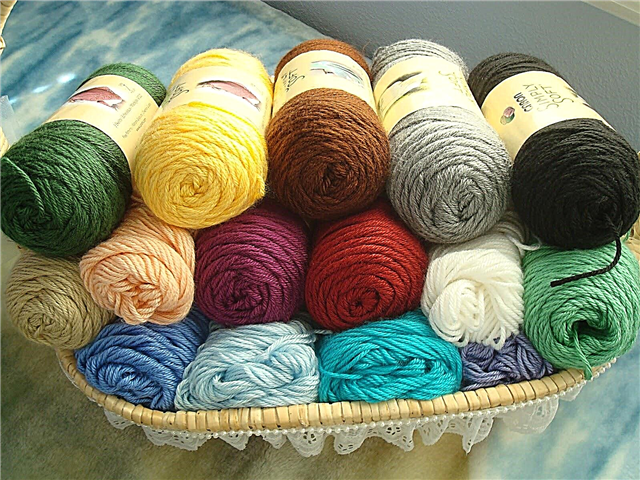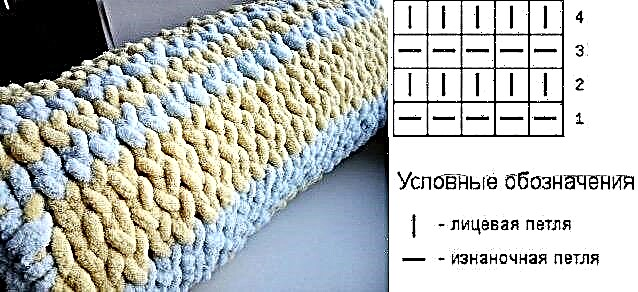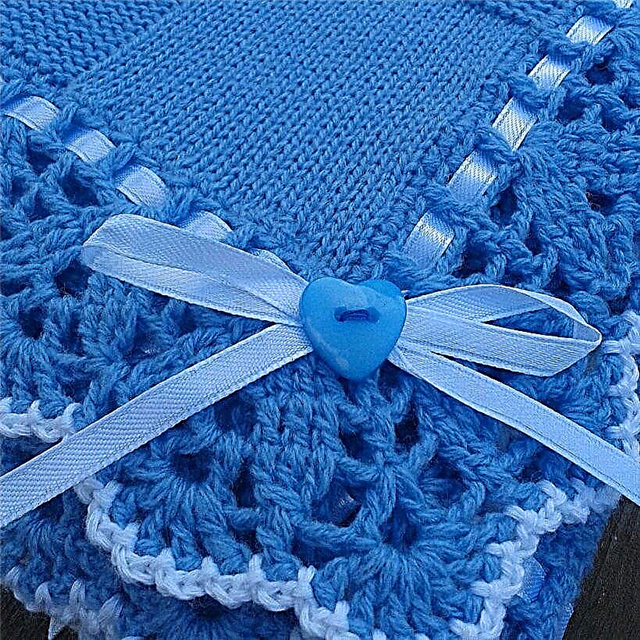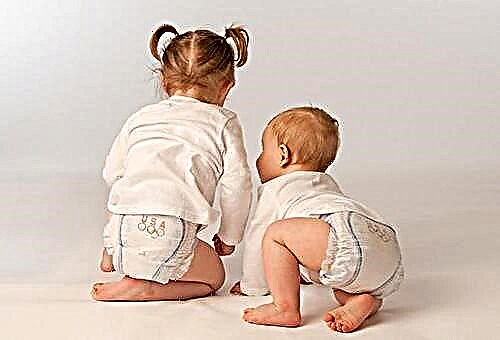Newborns need different blankets: small, large, thick, thin, for winter and summer. You can not only buy them in the store, but also make them yourself. One of the popular types of needlework is knitting, of course, craftswomen will want to make knitted baby blankets and blankets for newborns with their own hands.

Knitted blanket for baby
Benefits of knitted blankets
In addition to the warmth of mother's hands and original design, a knitted blanket for a newborn has useful qualities for a mother and baby:
- Will serve as a beautiful bedspread in the baby's bed;
- It is convenient to use it for a walk and to shelter a baby when he sleeps, in the summer;
- The soft knitted blanket can be used as a spacer between the mattress and the sheet. Such a coating will add softness and warmth in winter;
- Knitted blankets for newborns, tied for discharge, will highlight the child's clothes with their originality and unusual texture;
- When the baby grows up and plays on the floor, such an object will turn into a comfortable rug.
Important! A knitted blanket for a newborn is made using simple knitting techniques, and the process does not imply the arrangement of complex-shaped parts, so even a novice craftswoman can handle it.
Preparation for knitting
Before starting work, you need to choose a knitting method (knitting or crocheting), suitable threads and determine the dimensions of the product.
Spoke selection
If the fabric is solid, then the knitting needles should be long enough, since the size of the blanket is relatively large. The exception is canvases sewn from separately linked squares and stripes. When there is not enough length of ordinary knitting needles, you can take circular ones.
The size of the knitting needles in diameter depends on the desired thickness of the product, the selected threads, the knitting pattern. The most commonly used:
- numbers 2.5; 3; 3.5; 6 if straight knitting needles are used;
- numbers 3.5; five; 7 when applying circular.
Important! Typically, the numbers of the knitting needles used for this type of thread are indicated on the yarn label.
Which yarn to choose
To make a blanket for a child with your own hands, you need to choose yarn, which will be safe for the baby and provide him with comfortable warmth in accordance with weather conditions:
- for summer - light threads;
- for winter - thicker, with a content of wool and other warm components.

Yarn for knitting
The main recommended varieties:
- 100% cotton. Suitable for a summer blanket. Products made from such yarn are harsh, so it is better to choose cotton threads with polyacrylic, then the blanket will turn out to be much softer;
- Acrylic. Synthetic yarns are also used for summer blankets. It will turn out soft but dense. There is a special acrylic yarn that is suitable for children. This is indicated by the information on the packaging;
- 100% wool. A good choice for a winter blanket, but sometimes irritating to the skin. It is better to buy mixed yarns consisting of several natural ingredients with the addition of acrylic. For example, wool with bamboo and acrylic or wool with alpaca and acrylic.
When choosing threads for knitting, consider:
- It is not recommended to use fleecy yarn, as the hairs will get in the way, getting into the baby's face;
- Low-quality acrylic will affect the performance of the product (the blanket will stretch, losing its shape);
- It is better to choose thicker cotton yarn. It is necessary to ensure that the threads are free from defects. The thinner the threads, the shorter the service life of the product.
Choosing the size of the blanket
The dimensions of the knitted blanket for the baby are approximately the same as the diapers. To make it last longer, it is better to knit large items. The minimum dimensions are 90x90 cm, such a knitted blanket is suitable for a newborn at discharge. The maximum, more practical dimensions are 100x140 cm.
Calculation of the amount of yarn
To find out how many threads you need to knit a blanket, you must first tie a square with a side of 10 cm, and then wash it.
Important! A preliminary wash of a sample of the product is needed to evaluate how the size of the blanket will change after it.
In the future, you need to do:
- Measure the side of the knitted square after washing and drying. Calculate how many such parts will be in the finished blanket;
- Calculate the number of loops in order to know how many of them will need to be recruited for knitting;
- Dissolve the square, after that measuring the length of the threads that were used;
- Multiply the resulting figure by the estimated number of squares.
Important! If on the package with yarn there is information only about weight, and not about length, then it is not necessary to dissolve the previously tied and washed square, it is enough to weigh it.
Additional factors that can affect yarn consumption:
- thin threads are consumed more;
- knitting dense patterns requires an increase in the amount of yarn, openwork - on the contrary.
Knitting patterns
Various knitting patterns can be found online or in magazines. Experienced craftswomen are able to come up with them themselves.
Knitting fabric
Beginners need to choose the simplest schemes. Good to use for knitting with woolen threads the "Putanka" pattern, where the front and back loops alternate:

Pattern of the "Putanka" pattern
- Dial the calculated number of loops;
- Several rows are knitted using garter stitch (front loops);
- To keep the strip of equal width around the entire perimeter of the product, you must first knit as many front loops as there are rows in garter stitch. Then go to "Putanka", alternating front and back loops, and finish again with the same number of front;
- Continue until the plaid reaches the desired size, use garter stitch for the last few rows.
The simple pattern below is used to knit a plush blanket for a newborn with your own hands.

Pattern for a plush blanket
Instructions
The important stages in creating a knitted blanket for a child with your own hands are the first (set of loops) and the last (closure).
Knitting start
Description of the sequence of actions when a set of loops:
- You need to start not from the end of the thread, but by rewinding a small segment (at the rate of 40 cm for about 15-20 loops);
- Keep closed knitting needles in your right hand, a thread in your left;
- Wrap the index finger of the left hand with a working thread, and hold it with the other fingers of a half-open palm so that it can move freely.
Then proceed according to the scheme shown in the figure.

A set of loops for knitting needles
After dialing the required number of loops, pull out one knitting needle.
Final stage
Loops are closed according to the following scheme.

Loop closure
When the work is finished, the ends of the thread are closed.
Pattern options
Simple, repeating patterns are suitable for children's blankets, the elements of which will not be large.
Several possible schemes:
- Rhombuses;

Diagram of the "Rhombus" pattern
- Network;

Braid pattern
- Pigtails.

Pattern of the "Pigtails" pattern
You can knit not only plain blankets: traditionally for a boy - blue, for a girl - pink, but also colored. For example, make multi-colored squares with different patterns, and then sew them.

Plaid from colored squares
Plaid decoration
You can add decorative elements to knitted blankets for newborns. This should be done after washing and drying the finished product. Ribbons, lace and other materials are used for decoration. They need to be sewn using monofilament because of its exceptional strength. Otherwise, decorative elements can partially come off, and the blanket will lose its elegant look.

Decorated plaid
Knitted blankets for babies are good because they can serve several children and become a real family value. They will not only decorate the stroller, but will also be a useful thing for the child.



